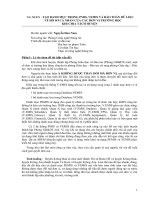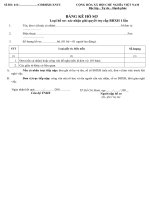hồ sơ cá nhân
Bạn đang xem bản rút gọn của tài liệu. Xem và tải ngay bản đầy đủ của tài liệu tại đây (206.8 KB, 9 trang )
THE 28
TH
CONFERENCE
OF THE FEDERATION OF ENGINEERING ORGANIZATIONS
CAFEO 28 HANOI VIETNAM, 30
TH
NOV. - 2
ND
DEC., 2010
TITLE:
BIOHYDROGEN PRODUCTION BY ANAEROBIC
BAFFLED REACTOR FROM WASTEWATER OF
SEASONING SAUCE FACTORY
AUTHOR(S)’
NAME(S):
Mr.Verapat Rittapirom* and
Associate Professor, Doctor Thares Srisatit**
ORGANIZATION
& DESIGNATION:
Department of Environmental Engineering,
Chulalongkorn University, Bangkok Thailand.
ADDRESS:
359/133 Soi 3 Moo 5 Sub-district Salaya district
Puttamonthon Province Nakhonprathom 73170*
Department of Environmental Engineering,
Chulalongkorn University, Bangkok Thailand.**
TEL:
086-5887892*
081-9272352**
FAX:
02-2186666**
EMAIL:
*
**
Verapat
Rittapirom
BIOHYDROGEN PRODUCTION BY ANAEROBIC BAFFLED
REACTOR FROM WASTEWATER OF SEASONING SAUCE FACTORY
Verapat Rittapirom* and Thares Srisatit**
Department of Environmental Engineering, Chulalongkorn University,
Bangkok Thailand,
*
**
ABSTRACT
Hydrogen power has long been heralded as the renewable energy source of the
future because of its cost effectiveness and low environmental impact. So, this
research it is very interested in hydrogen (H
2
) gas production by using a three
chambered anaerobic baffled reactor (ABR) from wastewater of seasoning sauce
factory (the average total COD value was found to be around 14,000-18,000 mg/l and
pH~3-4). The reactor was inoculated with thermally pretreated anaerobic sludge (80
°C and 110 °C 30 minutes) compare with non pretreated and operated with constant
hydraulic retention time (HRT) of 5 days at room temperature. H
2
is generated under
the acidogenesis and acetogenesis phase before transforming to be methane (CH
4
).
While, ABR operation found that inoculated with thermally pretreated at 110°C
promoted % hydrogen production in biogas with initial pH 5 showed higher H
2
production of 39-41% of the maximum were reported. The ABR has the potential to
provide a higher efficiency at higher loading rates and be applicable for extreme
environmental conditions and inhibitory compounds.
INTRODUCTION
Rising oil prices, finite fossil fuel reserves, environmental degradation, and
concerns about looming climatic changes are driving a concerted search for renewable
energy sources. A large fraction of current fossil fuel consumption is due to the
transportation sector which relies almost exclusively on the use of liquid fossil fuels.
Partial or complete replacement of presently used carburants, gasoline or diesel, with
a renewable energy carrier is thus key to averting or reducing the impending crisis
(Hallenbeck, 2009). The need for alternative energy sources has increased in recent
years, due to rapid depletion of fossil fuels. Direct utilization of fossil fuels results in
considerable Environmental problems due to CO
2
, SO
X
, NO
X
emissions causing air
pollution and global warming. Hydrogen gas is a clean fuel with no CO
2
emissions
and can easily be used in fuel cells for electricity generation. Besides, hydrogen has a
high energy content of 122 kJ/g, which is 2.75 times greater than hydrocarbon fuels.
Hydrogen is considered as the major energy carrier of the future. Biomass and water
can be used as renewable resources for hydrogen gas production (Argun et al., 2008).
Bioprocesses have been given special attention for hydrogen production in the last
thirty years due to operation under mild conditions (25–35
o
C, 1 atm), the production
of bio-hydrogen from renewable sources such as biomass has considerable advantages
over other alternatives, Biohydrogen production can be realized by anaerobic (dark
fermentation) microorganisms using carbohydrate rich biomass as a renewable
resource (Kapdan and Kagi, 2006).
This is an experimental research in laboratory, initial screening and optimize
of initial pH that significantly influence on hydrogen production from wastewater
of seasoning sauce factory in a continuous bio-hydrogen process using anaerobic
mixed cultures in the Anaerobic Baffled Reactor (ABR) to study the performance of
H
2
production and optimum pH condition on H
2
production . All of experimental
study the microbial for H
2
production by temperature control during fermentation for
3 point i.e. at the worst case (%minimum hydrogen production), medium case
(%medium hydrogen production) and best case (the optimum which %maximum
hydrogen production) using Gas Chromatography-TCD detector(Thermo Finnigan).
MATERIALS AND METHODS
1. Anaerobic Baffled Reactor (ABR)
The ABR consisted of a rectangular, Plexiglas reactor (inside dimensions:
length = 42 cm, height = 35 cm, width = 12 cm) with active volume about 12 L which
divided into three compartments. Round openings with a diameter of 2.5 cm from the
backside of the Plexiglas sheets separated the compartments. These openings were
placed at the bottom to create sufficient contact between biomass and substrate. The
flow over the horizontal plane of the reactor was reversed once a week. A weekly
change in flow direction was chosen to prevent a pH drop due to VFA build up in the
initial compartment and to prevent unequal biomass levels due to anticipated biomass
migration between compartments. The samples will be withdraw from the ABR
reactor. A structure and schematic of the lab-scale of ABR used in this study is
presented in Figure 1.
Fig. 1 Schematic configuration of lab-scale ABR .
2. Material
- 3 model of lab-scale ABR (12 L active volume follow fig. 1).
- 3 of Metering pump.
- 3 of Counter gas by using water displacement.
- 6 of 15 L Plastic tank.
3.
Feed wastewater and mix cultures inoculum preparation
Seasoning sauce factory wastewater, which was used in this investigation, was
obtained from a local processing plant Bangpu Industrial Estate, Samut Prakan
province, Thailand. The raw wastewater contained COD of 14,000–18,000 mg/L,
Effluent
Tank
Total gas
Measurement
Feeding
Tank
pH meter
Gas sampling
1
2 2
2
3
4
5
⊗
⊗
⊗
BOD of 6,000–10,000 mg/L, total solids (TS) of 10,260-10,752 mg/L, total suspended
solids(TSS) of 3,400–4,000 mg/L, total nitrogen (TN) of 14 mg/L, total phosphorus
(TP) of 9.68 mg/L ,total volatile fatty acid(VFA) of 1483 mg/L and had a pH of 3.7–
4.0.
The reactor was initially seeded with flocculent anaerobic sewage sludge
collected from one of the UASB reactor located from fruit juice industry,
Nakhonprathom, Thailand and was then introduced uniformly into all three
compartments of the ABR. Each 4 L compartment contained 1.2 L sludge.
The
microorganism seed was heat treated at various temperatures ranging from 80ºC to
110 ºC for 30 minutes to inactivate the non-spore forming methanogens. The heat-
treated inoculum (HTI) was spore stained. The harvested spore forming acitogens are
used for producing hydrogen from seasoning sauce wastewater.
4. Analytical methods
COD, BOD, TSS, TS, pH, and oxidation-reduction potential (ORP) were
measured according to standard methods(APHA, 1995). The biogas constituents (H
2
,
CO
2
and CH
4
) were analyzed by a gas chromatogram (GC, Thermo Finnigan) with a
thermal conductivity detector (TCD) and shin carbon column packed. The
concentrations of VFAs were measured using another gas chromatograph(GC, Agilent
4890D) with a flame ionization detector (FID)and a2 m stainless column packed with
Porapak GDX103 (60/80 mesh).COD, pH, biogas volume and ORP were measured or
monitored daily.BOD, VFAs, TS, TSS and biogas yield were measured once every 5
days .
5. Operation of anaerobic baffled reactor
Barber and Stuckey (1998) had suggested to initially use long detention time
(80 h) to startup the ABR and to reduce it in stepwise fashion while maintaining a
constant incoming substrate concentration.
It provides greater reactor stability and
superior reactor performance.
The investigation was carried out with a constant hydraulic retention time
(HRT) and varying influent COD concentration .The ABR was fed with different
concentration diluted seasoning sauce factory wastewater at constant HRT value
corresponding to organic loading rate of 1 and 2 kgCOD/m
3
-d, respectively. The
experiment in this study consisted of two subsequent [A = initial pH 3-4 and B =
initial pH 5] (shown in Table 1).
Table 1 The operation parameter of ABR start up.
The loading rates were only increased when steady state conditions were
obtained for the existing loading condition. In general, a steady state condition was
believed to have been reached when a relatively small variation in the levels of
determinants of the final effluent for two different samples. The ABR reactor was
Operation
stage
HRT
(days)
T (°C) Influent pH
value
Influent
COD
concentration
(mg/L)
OLR
(kgCOD/ m
3
d)
1st stage
2nd stage
5
5
Room temp.
Room temp.
A and B
A and B
5,000
11,000
1
2
operated continuously until reached constant COD removal during the start-up period.
Then it was operated with increasing COD concentrations from 5,000– 5,200 mg/L to
9,000–11,000 mg/L, When effluent COD in the bioreactor became constant, the
samples were collected and subjected to the analysis of the following parameters, i.e.
feed and effluent COD, effluent total volatile acid; reactor pH, gas production and
composition.
The experiment in this study consisted of two subsequent [A = initial pH 3-4
and B = initial pH 5], each subsequent were as follow:ABR1 non-treated
sludge.ABR2 thermally pretreated anaerobic sludge 80 °C for 30 minutes and ABR3
thermally pretreated anaerobic sludge 110 °C for 30 minutes) by ratio between
anaerobic sludge : wastewater = 30% : 70% [shown in Fig. 2]
RESULTS AND DISCUSSION
1. COD removal.
Feeding was started at a soluble COD feed concentration of 5,000 mg/L at
HRT of 5 days (OLR = 1 kg COD/m3d) (Fig. 3A and 3B).From the very decreasing
COD removal effluent were in the range of 40-50% of influent COD and after 15 days
of startup, feeding soluble COD of 11,000 mg/L until effluent COD of both initial pH
3-4 and 5 have stability of the process. After that operation process was started at
14,000-18,000 mg/l COD concentration of raw seasoning sauce wastewater from data
in Fig. 3A and 3B at HRT of 5 days[day 36-60].
Wastewater [A and B]
ABR 1 ABR 2 ABR 3
Parameters analysis
Fig. 2 Experimental procedure
Sludge : Wastewater ratio = 30% : 70%
Biogas analysis Effluent analysis
- Volume of biogas production
- % Hydrogen in biogas
- COD - BOD
- VFAs - TS & TSS









